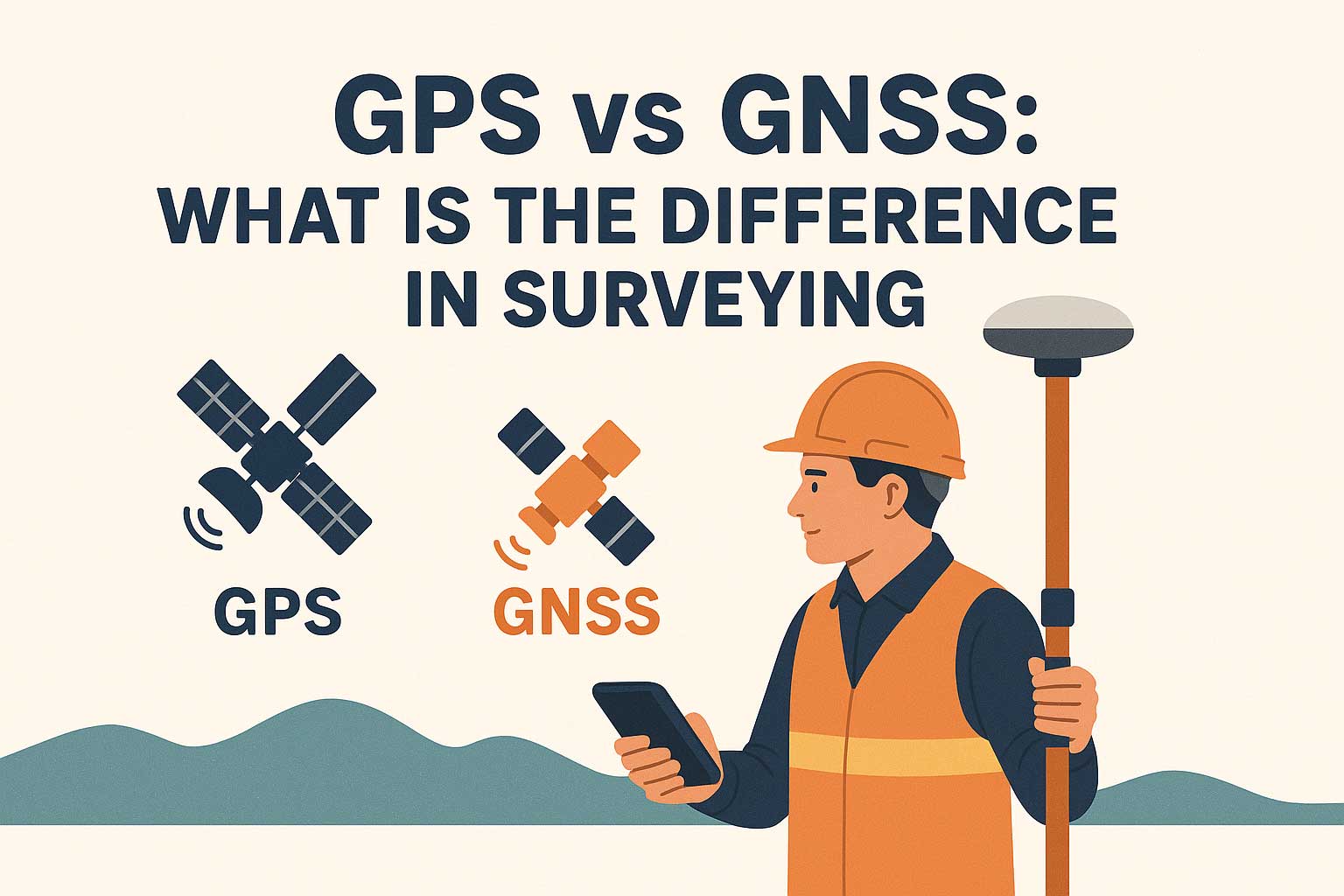Quick answer: GPS is the United States’ satellite positioning system, while GNSS (Global Navigation Satellite System) is the umbrella term that includes GPS plus other constellations like GLONASS, Galileo, BeiDou, QZSS, and IRNSS. For surveyors, using full GNSS generally means more satellites, better geometry (PDOP), faster fixes, and higher reliability under trees, in urban canyons, and in challenging environments.
Table of Contents
- What Is GPS?
- What Is GNSS?
- GNSS Constellations Explained
- RTK vs PPK vs PPP – Where GPS/GNSS Fits
- Accuracy, Availability & Reliability Compared
- When to Choose GPS-Only vs Full GNSS
- GNSS + Total Station: Best-of-Both Worlds Workflow
- Buying Tips for Used GNSS Survey Gear
- FAQ
What Is GPS?
GPS (Global Positioning System) is the US-operated satellite navigation system. Early (and some budget) receivers were “GPS-only,” meaning they could see and use only GPS satellites. While still accurate, GPS-only receivers often struggle with:
- Fewer satellites available at any given time
- Slower RTK initialization (fix time)
- Weaker performance in obstructed environments (trees, buildings, tunnels)
What Is GNSS?
GNSS refers to all global (and regional) satellite navigation systems. A GNSS-enabled receiver tracks multiple constellations simultaneously, increasing the number of satellites, improving geometry (PDOP), and stabilizing your solutions in demanding environments.
GNSS Constellations Explained
- GPS – United States
- GLONASS – Russia
- Galileo – European Union
- BeiDou – China
- QZSS – Japan (regional)
- IRNSS/NavIC – India (regional)
Modern survey-grade receivers support multi-constellation and multi-frequency tracking (e.g., L1/L2/L5, E1/E5, etc.), which dramatically boosts performance for RTK/PPK workflows.
RTK vs PPK vs PPP – Where GPS/GNSS Fits
RTK (Real-Time Kinematic)
Uses a base station or network (e.g., CORS) to provide real-time corrections. GNSS receivers generally get a faster, more robust fixed solution vs GPS-only.
PPK (Post-Processed Kinematic)
Data is collected in the field and processed later. Multi-constellation support increases the chance you’ll have enough quality observations to get millimeter-level results in post.
PPP (Precise Point Positioning)
Uses precise satellite orbit & clock data. Convergence can be slow, but multi-constellation GNSS shortens convergence time and improves reliability.
Accuracy, Availability & Reliability Compared
| Criteria | GPS-Only Receiver | Full GNSS Receiver |
|---|---|---|
| Satellites in view | Lower | Higher (GPS + GLONASS + Galileo + BeiDou …) |
| Fix time (RTK) | Slower | Faster, especially in marginal conditions |
| Accuracy consistency | Good in open sky | Better across varied environments |
| Multipath robustness | Weaker | Stronger (more observations & frequencies) |
| Price (typically) | Lower | Higher, but dropping in recent years |
When Should You Choose GPS-Only vs Full GNSS?
Choose GPS-Only If:
- You work mostly in open-sky, rural environments
- You’re on a tight budget and can accept slower fix times
- Your work doesn’t demand uptime in difficult conditions
Choose Full GNSS If:
- You operate in urban, forested, or mountainous areas
- You need fast, reliable RTK fixes
- You want future-proofing (new signals, constellations)
- You handle high-precision engineering, construction, monitoring
GNSS + Total Station: Best-of-Both-Worlds Workflow
Survey teams often combine a GNSS rover for control point establishment and rapid topo with a robotic total station for line-of-sight precision (e.g., building stakeout, monitoring, tunnels). This hybrid workflow gives speed, redundancy, and robustness in environments where satellites are partially blocked.
Buying Tips for Used GNSS Survey Gear
- Check constellation & frequency support: Ensure it tracks GPS, GLONASS, Galileo, BeiDou and at least L1/L2 (ideally L5/E5).
- Verify RTK licensing: Some brands sell RTK as a software option—make sure it’s enabled.
- Inspect batteries, chargers, and connectors: Accessories can add surprising cost.
- Ask for a recent calibration or field accuracy test report.
- Confirm data compatibility: Can it export to your CAD/GIS package (RINEX, CSV, DXF)?
Need help picking a GNSS receiver? We stock pre-owned units from Leica, Trimble, Topcon, and Sokkia. Contact us and we’ll match the best model to your workflow and budget.
FAQ
Is GPS less accurate than GNSS?
In open-sky conditions, both can achieve high accuracy. But GNSS provides more satellites and frequencies, which improves reliability, fix speed, and accuracy consistency in tough environments.
Do I really need GLONASS, Galileo, or BeiDou?
If you survey in areas with obstructions, yes. More constellations = better availability and geometry, which equals better results.
Can older GPS-only receivers be upgraded to GNSS?
Sometimes—depends on the brand/model. Some require firmware, others need hardware (or it’s impossible). Always verify before buying.
Will a GNSS receiver replace my total station?
No. GNSS is unbeatable for speed and control in open-sky, but total stations still win for indoor work, tunnels, and applications where direct line-of-sight precision is required.
Looking for Affordable GNSS Survey Gear?
We sell tested, pre-owned GNSS receivers and robotic total stations with warranty and support.
👉 Browse our used inventory
📲 Chat with us on WhatsApp for stock & pricing
Next up in the series: “Top 5 Used Total Stations Under $5,000 (2025)” or “How to Check the Condition of a Used GNSS Receiver Before You Buy.” Tell me which one you want next!

